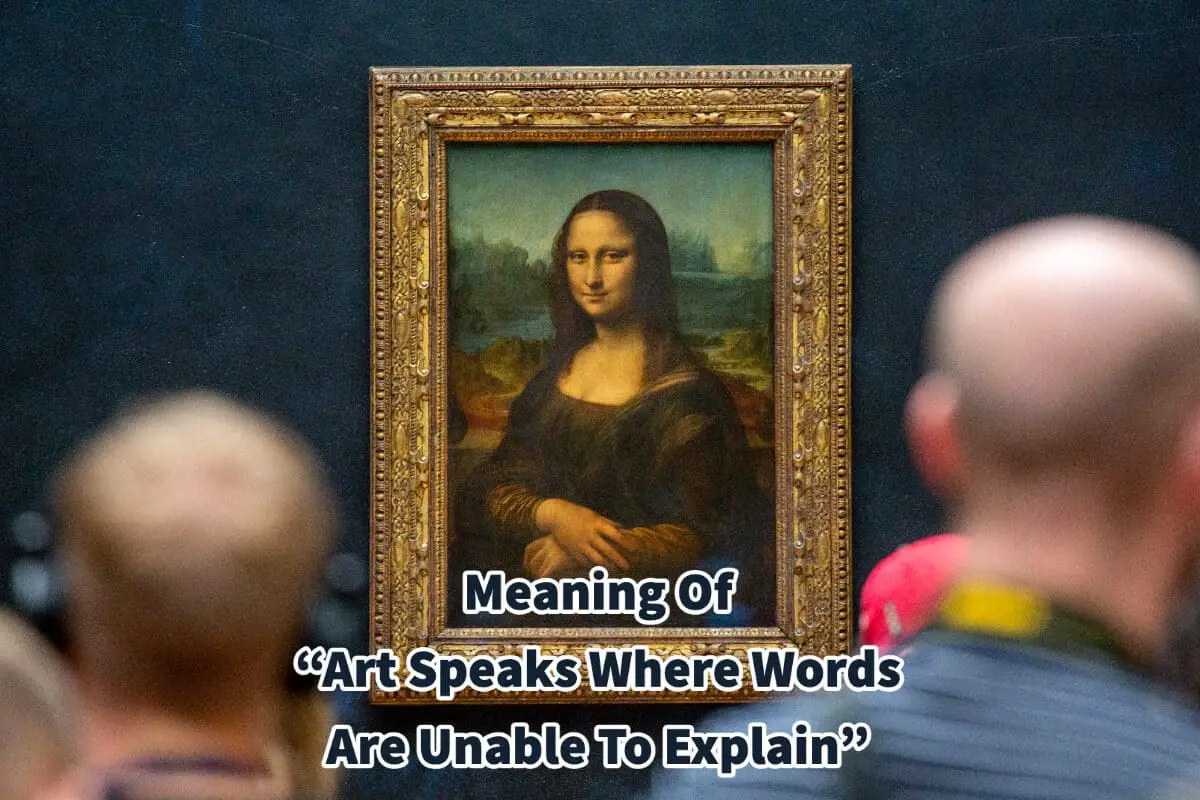A saying says, ” Art speaks where words are unable to explain.” In other words, Art can visually communicate things that the spoken or written word cannot.
“Art speaks where words are unable to explain” means that words, even though very powerful and profound, are not always able to convey the message as art can convey. Words are powerful, but an image or piece of art can be much more potent than the spoken or written word.
Table of Contents
- What “Art Speaks Where Words Are Unable To Explain” Means
- 15 Reasons Why Art is Integral to Every Human Civilization
- Frequently Asked Questions
- Related Questions
What “Art Speaks Where Words Are Unable To Explain” Means
The saying “Art Speaks Where Words Are Unable to Explain” means that words, even though compelling, are not always as powerful as an image or a piece of art. Our words can have a limited range in explaining the meaning behind something.
The written words are powerful, but an image can tell a story that words cannot fully tell.
Here are some ways that Art continues to speak where words are unable to explain fully:
An Art Image Is More Effective Than Words
The adage ”Art Speaks Where Words Are Unable” shows that images can be more effective than written or spoken words. There is another famous adage that says:
“A picture is worth a thousand words.”
Adage
This famous adage has been translated and used in multiple languages. But it means that images or pictures can speak and communicate things that words have a hard time communicating.
Today, the power of Art and images continues to play a compelling role in our society. Art can quickly show or convey a meaning that may be impossible for words to convey.
The Russian writer Ivan Turgenev said it best in 1861 when he wrote:
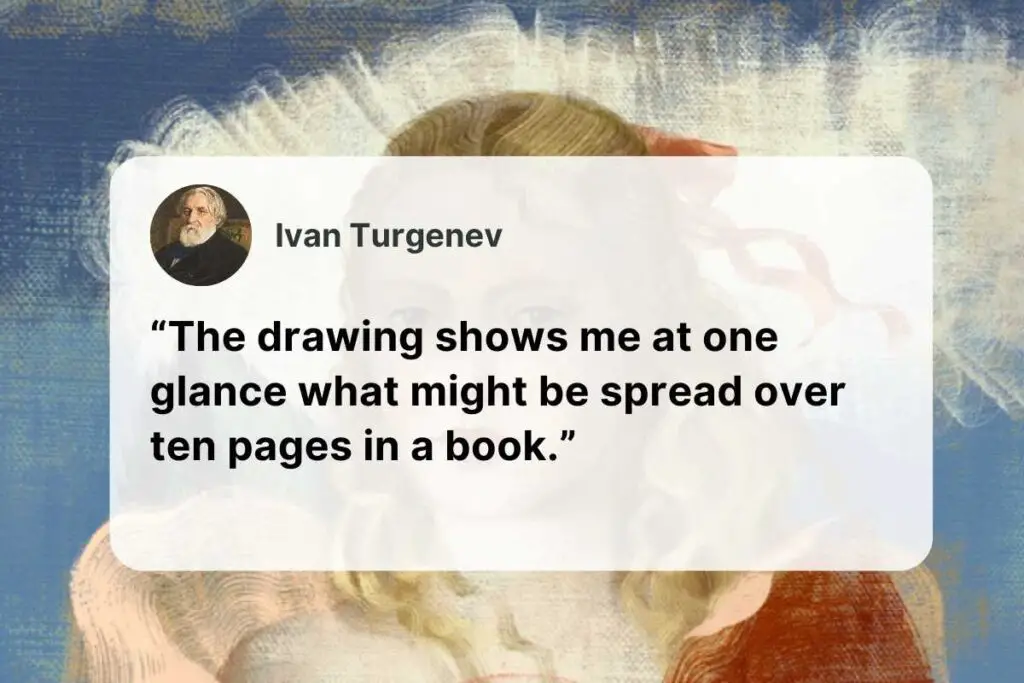
“The drawing shows me at one glance what might be spread over ten pages in a book.”
Ivan Turgenev
Ivan Turgenev fully understood that one drawing or one piece of Art could convey a message that would take pages and pages in a book to convey.
The Power Of A Single Piece of Art
Leonardo da Vinci’s Mona Lisa continues to be the most popular and sought-after picture in the world. About six million people visit the LouvreMuseum in Paris, France, to see the Mona Lisa.
Many of those same visitors may buy tickets to the Louvre Museum only to see the Mona Lisa and not much else. About 25,000 to 30,000 people spend about five minutes catching a glimpse of Leonardo’s famous Mona Lisa painting daily.
The Mona Lisa is an excellent example of the power that one single image of art can have on the world; the Mona Lisa’s popularity has not waned and continues to increase. Her famous smile draws many to want to see this famous painting.
Leonardo da Vinci fully understood the power that Art could have when compared to the written word. Leonardo da Vinci was known to say:
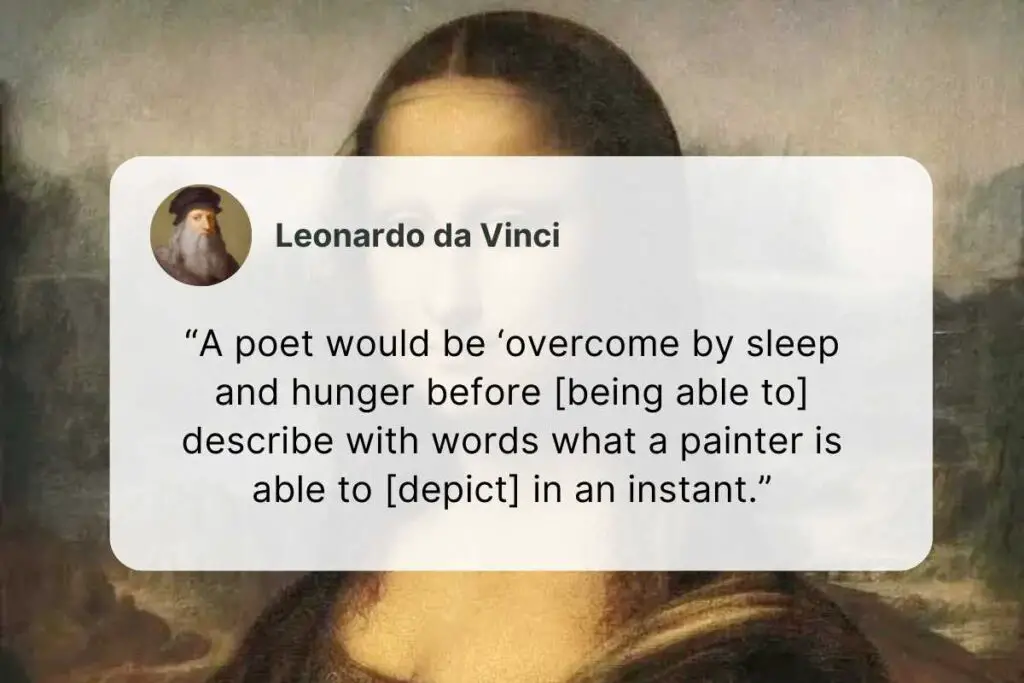
“A poet would be ‘overcome by sleep and hunger before [being able to] describe with words what a painter is able to [depict] in an instant.”
Leonardo da Vinci
The Colors and Shapes Of Art Powerfully Communicate
An artist puts a series of colors and shapes on his canvas to communicate their message to the world. The artist does not need to have any words as the power of what they are showing or the artistic image is what is being communicated to the world.
I believe that the artist Georgia O’Keeffe said it best when she said this about her art:
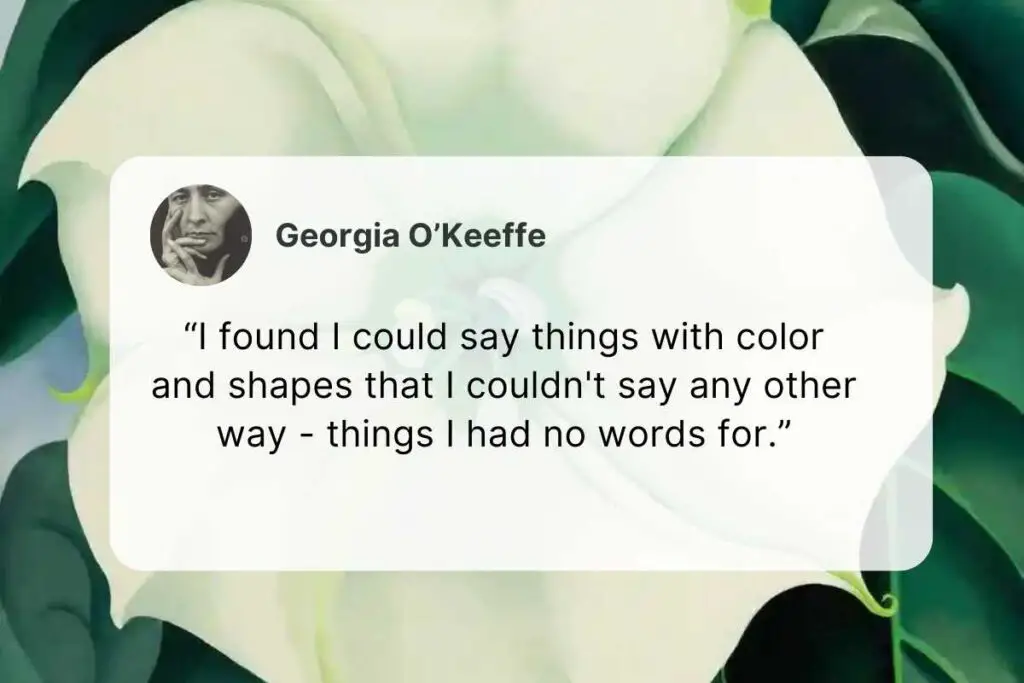
“I found I could say things with color and shapes that I couldn’t say any other way – things I had no words for.”
Georgia O’Keeffe
As Georgia O’Keeffe said, her art could convey to the world meaning and understanding that she would never be able to put down in words fully. She beautifully explained that art could convey meanings through shapes and colors in ways that words cannot.
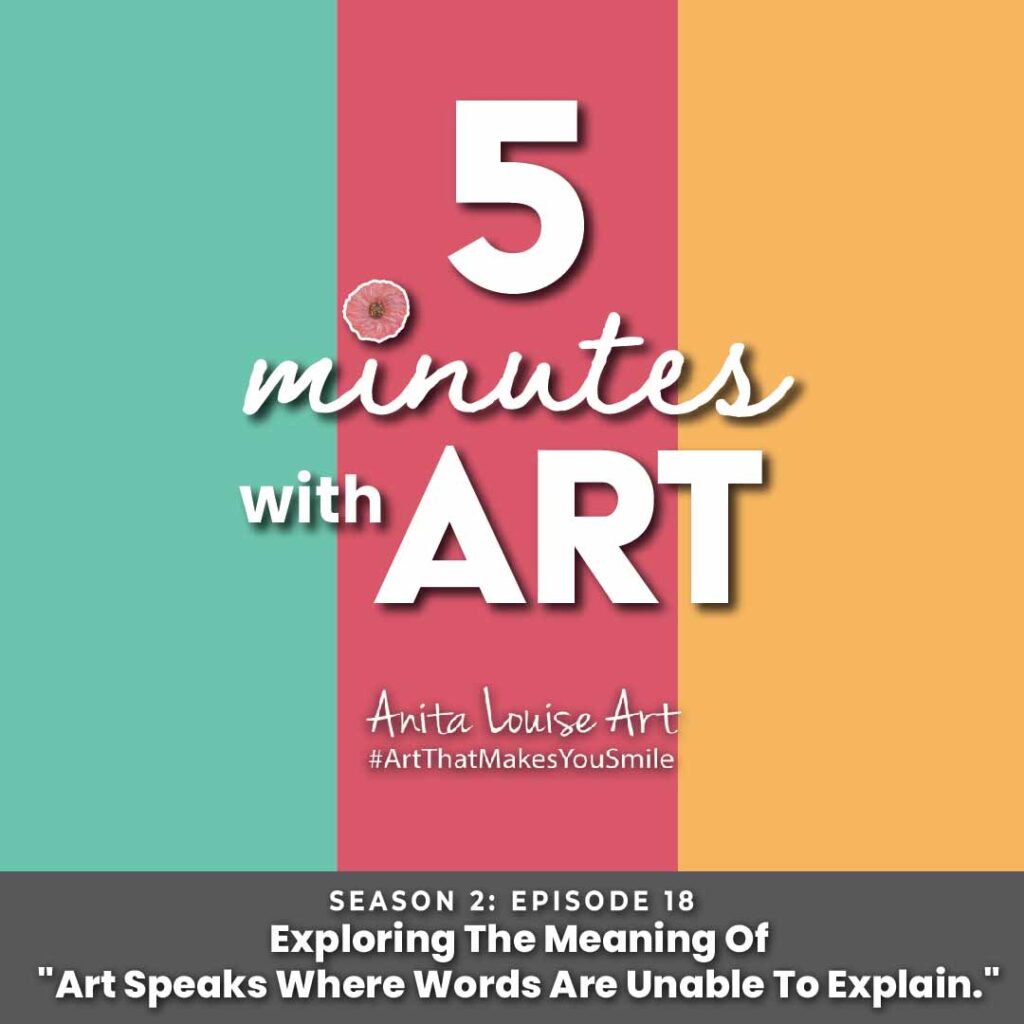
Listen To Our Podcast About Exploring The Meaning Of “Art Speaks Where Words Are Unable To Explain.” by clicking here.
Multiple Ideas Can Be Conveyed By One Piece Of Art
Art can also convey different meanings to different people, so art can, in a sense, become a very personal experience. Viewing art is unique and, in most cases, also based upon our own lives and influences, which adds to the power of art and a single image.
Art gives us an image of the artist’s soul and understanding. Because of this, art can be very subjective, and how one person sees art may differ from another. That is one of the beauties of art in that we may all see and experience it a bit differently.
Georgia O’Keeffe also said it best when she said:
“I had to create an equivalent for what I felt about what I was looking at – not copy it.”
Georgia O’Keeffe
Art is compelling! We should all be thankful to have skill and creative images in our lives that can convey to us meanings and understandings that cannot be conveyed in any other way, even with words.
The power of art is that art, especially great art, continues to inspire and uplift us while simultaneously conveying messages that words alone simply cannot. That is how art can continue to speak to us where words cannot fully and thoroughly explain the meaning.
15 Reasons Why Art is Integral to Every Human Civilization
Across time and continents, art has been a defining component of human expression and culture.
Here are 15 reasons that highlight the indispensable role of art in nearly every civilization:
- Universal Expression: Art provides a universal language that transcends linguistic barriers, allowing diverse communities to communicate emotions, ideas, and shared experiences.
- Cultural Identity: Through art, civilizations crystallize their values, beliefs, and unique characteristics, establishing a sense of identity and continuity.
- Historical Record: Art chronicles history. From ancient cave paintings to modern installations, it captures the zeitgeist, pivotal moments, daily lives, and evolutionary milestones of societies.
- Spiritual and Religious Significance: Many civilizations use art in religious rituals, as symbols of devotion, or to depict and honor deities, encapsulating their spiritual beliefs and practices.
- Therapeutic Value: Art has always been a medium for emotional catharsis. Creating and experiencing art can be healing, providing solace and introspection.
- Social Commentary: Art offers a platform to challenge societal norms, address injustices, and advocate for change, acting as both a mirror and conscience for societies.
- Economic Impact: Throughout history, art has been a trade commodity, a sign of affluence, and in modern times, a significant contributor to the economy through industries like tourism, design, and entertainment.
- Education and Enlightenment: Art stimulates intellectual inquiry, prompts philosophical discourse, and encourages cognitive development, making it a powerful educational tool.
- Aesthetic Appeal: The intrinsic beauty of art enhances our surroundings, influencing the design of everything from monumental architecture to household items.
- Cultural Exchange: Art facilitates the exchange of ideas and perspectives between civilizations, fostering mutual appreciation, understanding, and diplomacy.
- Social Cohesion: Shared artistic experiences, whether through festivals, performances, or community projects, strengthen communal bonds and foster a sense of belonging.
- Celebration of Individuality: While reflecting collective identity, art also celebrates personal expression and creativity, championing the uniqueness of each artist.
- Technological Advancements: Many artistic endeavors, especially in architecture and craftsmanship, have driven technological innovations to achieve the envisioned aesthetics or functionalities.
- Moral and Ethical Reflection: Through stories, allegories, and depictions, art prompts societies to reflect upon moral and ethical values, guiding behavior and laws.
- Legacy Creation: Art endures. Long after civilizations fade, their art remains, preserving their legacy, achievements, and essence for future generations.
Art is not just a luxury or a decorative afterthought. It’s the heartbeat of human civilization—a testament to our experiences, aspirations, struggles, and triumphs. Through the annals of history, art has shaped, reflected, and enriched the human experience, underscoring its profound significance in the tapestry of our shared heritage.
Anita Louise Art is dedicated to art education, great artists, and inspiring others to find and create their art. We love art that uplifts and inspires. #ArtToMakeYouSmile! #ArtToMakeYouHappy!
If you are interested in seeing any of my art, you can find out more by clicking here. If you are interested in what inspires me and my paintings, you can discover more by clicking here.
We have a free newsletter and would love you to be part of our community; you can subscribe to the newsletter by clicking here. If you have any questions, I would be happy to talk to you. You can reach me, Anita, by clicking here.
Subscribe to our Anita Louise Art YouTube Channel filled with great videos and information by clicking here.
Join us for our podcast “5 Minutes With Art.” Spend just 5 minutes a week with us to discover and learn about great art and artists. You can find out more about our podcast by clicking here.
Frequently Asked Questions
What does “Art speaks where words are unable to explain” mean?
This phrase suggests that sometimes art can express feelings, emotions, and ideas that are difficult or impossible to convey through words.
What types of art can speak where words are unable to explain?
Any form of art can potentially communicate beyond words, including visual arts like painting and sculpture, performing arts like dance and theater, and literary arts like poetry and fiction.
Why is art so powerful?
Art has the power to evoke emotions, convey messages, and express experiences in a way that is unique and often more impactful than language
How can I appreciate art that speaks where words are unable to explain?
To appreciate this type of art, it’s important to approach it with an open mind and allow yourself to be moved by the emotions and messages conveyed through the artwork.
How can art help us understand complex social issues?
Art can provide a visual representation of social issues, allowing us to better understand and empathize with those affected.
How does art help us connect with others?
Art can create a sense of shared experience and can help us empathize with others by providing a window into their emotions and experiences.
Can art help us cope with trauma?
Yes, art can be a powerful tool for coping with trauma by allowing individuals to express and process difficult emotions in a non-verbal way.
What is the role of art in society?
The role of art in society is multifaceted, but it can serve as a means of communication, expression, reflection, and cultural preservation.
Related Questions
Why Do People Say, ”Life Is Like Drawing Without An Eraser?
Often, artists, myself included, will use an eraser to remove any marks or measurements we may have made on a paper to measure out and organize their drawings or artwork on their canvas or paper. For most artists, having a good eraser is essential.
By clicking here, you can learn more by reading Why Do People Say, ”Life Is Like Drawing Without An Eraser?.
Is Communism Good For The Arts?
Communism is not suitable for art, and for many artists under Communism art should have a purpose and way to help further the communist ideals and ideology. In a Communist society, many artists are labeled as dissidents; others are forced to use their talents to create propaganda art.
By clicking here, you can learn more by reading Is Communism Good For The Arts?.
12 Years Leonardo Painted Mona Lisa’s Lips, Facts Or Fiction?
There is no evidence to show that Leonardo da Vinci spent 12 years painting the Mona Lisa smile. Most scholars believe that he painted the painting in 4 years but then had the painting much longer in his possession. He could have worked on it a bit or adjusted it when he had it in his possession, but there is no evidence to show that.
By clicking here, you can learn more by reading 12 Years Leonardo Painted Mona Lisa’s Lips, Facts Or Fiction?.

